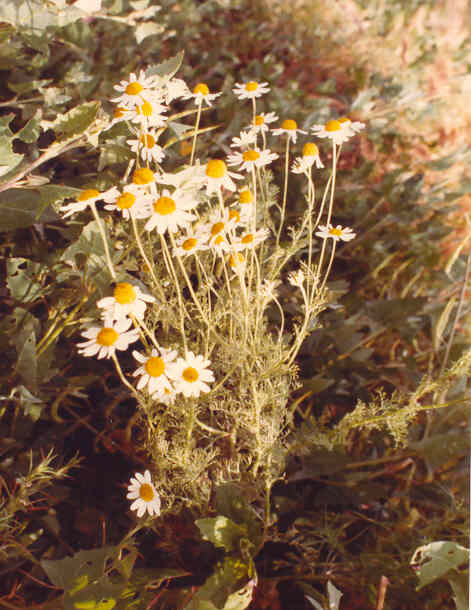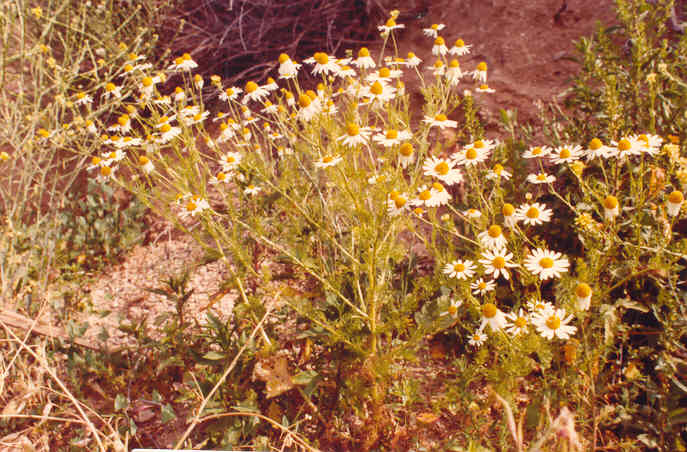
Anthemis cotula L
Asteraceae (Sunflower Family)
Europe
Mayweed
Dog Mayweed
 |
Anthemis cotula LAsteraceae (Sunflower Family)Europe
MayweedDog Mayweed
|
June Photo
Plant Characteristics:
Ill-smelling annual, 1-5 dm. high, +/- branched, subglabrous; lvs. mostly
2-6 cm. long, 2-3 pinnatifid into very narrow segms.; heads rather many,
short-peduncled, 1.5-2 cm. across; phyllaries +/- 2.5 mm., +/- pointed, green,
margins scabrous, pale brown; rays white, 5-11 mm. long, sterile; aks.
subterete, ca. 10 ribbed; pappus none.
Habitat:
Common weed in waste places, fields, etc.; much of Calif. April-Aug.
Name:
Anthemis, ancient Greek name of
the Chamomile. (Munz, Flora So. Calif.
114). Greek, kotyle, cup-shaped; also a plant, probably the navel-wort. (Jaeger
68). I fail to see the reason for
using this name with this plant. (my
comment).
General:
Uncommon in the study area, having been found only three times, once on
the Castaways bluffs, again along the road northerly of Big Canyon, and finally
at Northstar Beach. Photographed in
the first two locations. (my
comments). Funk
& Wagnalls New Comprehensive
International Dictionary of the English Language. 1978.
pp. 192, describes camomile (chamomile) as a strongly scented bitter herb
of the genus Anthemis, especially the
European perennial A. nobilis, whose
bitter, aromatic leaves are used in medicine. If you know where you can find the
mayweed or camomile, Anthemis cotula,
make a hot fomentation of the flowers with water and vinegar for an ear wash
when it aches. (Fielder 64).
Chamomile, Matricaria chamomilla,
is indigenous to Southern Europe;
we have also a common or wild Chamomile, Anthemis
cotula, growing in the United States, but it is not considered as goods as
the German Chamomile for medicinal purposes.
The white flowers are the best; they have an aromatic agreeable bitter
taste, and peculiar odor. They
yield their properties to alcohol and water.
Chamomile is a tonic; one to two teacupfuls of the warm infusion will
usually cause vomiting. The cold
infusion is highly useful. The oil
is carminative and antipasmodic, and is used in flatulency, colic, cramp and in
the stomach. (Meyer 50).
About 60 species of Old World. (Munz,
Flora So. Calif. 114).
Text Ref:
Abrams, Vol. IV 388; Hickman, Ed. 198; Munz, Flora
So. Calif 114; Roberts 8.
Photo Ref:
June 4 83 # 24E; June 5 83 # 11.
Identity: by F. Roberts.
Computer Ref: Plant Data 295
No plant specimen.
Last edit 9/19/02.
 |
June Photo